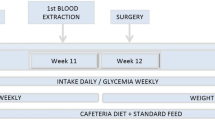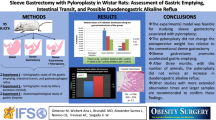Background: Many bariatric endocopic or surgical procedures performed today reduce gastric capacity and/or induce an early sensation of satiety, alone or in combination with a distal enteric intervention. A form of prosthetic gastric wrap was used in the past for treating obesity with a high rate of reintervention. Nissen gastric fundoplication used in the treatment of gastroesophageal reflux disease induces a small but significant weight loss. We report the effect of gastric greater curvature invagination on weight in rats. Methods: 30 rats were randomly divided into 3 groups. 10 rats in the first group (sham) were anesthesized and weighed. The rats from the second group (lap) were in addition submitted to a laparotomy plus visceral manipulation. In the third group (inv), invagination of the greater curvature of the stomach was added. All animals were weighed on the 7th and 21st days. They were then autopsied on the 21st day. Results: The mean body weight of the invagination group became statistically less than the laparotomy and sham groups at 7 and 21 days. The mean weight of the peritesticular fat pad from the inv group was also significantly less than from the sham group but not different from the lap group. Conclusion: Gastric greater curvature invagination significantly decreases weight in rats.
Similar content being viewed by others
Author information
Authors and Affiliations
Rights and permissions
About this article
Cite this article
Fusco, P.E.B., Poggetti, R.S., Younes, R.N. et al. Evaluation of Gastric Greater Curvature Invagination for Weight Loss in Rats. OBES SURG 16, 172–177 (2006). https://doi.org/10.1381/096089206775565203
Published:
Issue Date:
DOI: https://doi.org/10.1381/096089206775565203




